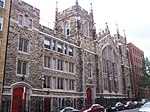Will Marion Cook House
Georgian architecture in New York (state)Houses completed in 1918Houses on the National Register of Historic Places in ManhattanNRHP infobox with nocatNational Historic Landmarks in Manhattan

The Will Marion Cook House is a historic townhouse at 221 West 138th Street, in the part of Harlem known as Strivers' Row in Manhattan, New York City. It was the home of Will Marion Cook (1869-1944), a leading African-American musician and composer of the period, from 1918 until his death in 1944. Cook was a major influence on later musicians including Sidney Bechet, Duke Ellington, and Josephine Baker. It was declared a National Historic Landmark in 1976.
Excerpt from the Wikipedia article Will Marion Cook House (License: CC BY-SA 3.0, Authors, Images).Will Marion Cook House
West 138th Street, New York Manhattan
Geographical coordinates (GPS) Address Nearby Places Show on map
Geographical coordinates (GPS)
| Latitude | Longitude |
|---|---|
| N 40.817777777778 ° | E -73.943611111111 ° |
Address
West 138th Street 231
10030 New York, Manhattan
New York, United States
Open on Google Maps









